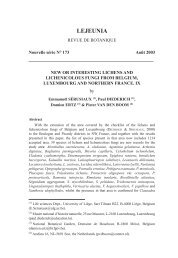The Lichens and Lichenicolous Fungi of Belgium and Luxembourg ...
The Lichens and Lichenicolous Fungi of Belgium and Luxembourg ...
The Lichens and Lichenicolous Fungi of Belgium and Luxembourg ...
You also want an ePaper? Increase the reach of your titles
YUMPU automatically turns print PDFs into web optimized ePapers that Google loves.
32 P. DIEDERICH & E. SÉRUSIAUX<br />
<strong>The</strong> beginning <strong>of</strong> the XXth century can claim acquaintance only with the French lichenologist<br />
M. Bouly de Lesdain (1869-1965), most <strong>of</strong> whose collections were unfortunately<br />
destroyed during the bombing <strong>of</strong> Dunkerque in 1940. As far as our study area is<br />
concerned, Bouly de Lesdain mainly worked near Dunkerque (France, dept. Nord) from<br />
where he described many taxa new to science (lichens <strong>and</strong> lichenicolous fungi). In<br />
<strong>Belgium</strong>, he notably collected near Spa. In northern France, another prominent<br />
lichenologist, Father J. Harm<strong>and</strong> (1844-1915) published a ‘Catalogue descriptif des<br />
lichens observés dans la Lorraine’ (Harm<strong>and</strong> 1894). This flora mainly concerns the<br />
southern part <strong>of</strong> the Lorraine, an area not studied in the present checklist.<br />
Towards the end <strong>of</strong> the thirties, P. Duvigneaud (1913-91) started his studies, particularly<br />
with the publication <strong>of</strong> his ‘Catalogue des <strong>Lichens</strong> de Belgique’, written in collaboration<br />
with L. Giltay (Duvigneaud & Giltay 1938) (Fig. 19). Just like the ‘Prodrome’ <strong>of</strong> De Wildeman,<br />
this catalogue is an invaluable reference, though it is a mere uncritical compilation<br />
<strong>of</strong> data extracted from literature <strong>and</strong> devoid <strong>of</strong> any chorological or ecological information.<br />
Between 1937 <strong>and</strong> 1952, P. Duvigneaud published many notes on Belgian lichens, especially<br />
a fascinating review <strong>of</strong> epiphytic cryptogamic communities (Duvigneaud 1942).<br />
Fig. 19. Excerpt from the ‘Catalogue<br />
des <strong>Lichens</strong> de Belgique’ by<br />
Duvigneaud & Giltay (1938: 19).<br />
Extrait du ‘Catalogue des <strong>Lichens</strong><br />
de Belgique’ par Duvigneaud &<br />
Giltay (1938: 19).<br />
Passage uit de ‘Catalogue des <strong>Lichens</strong><br />
de Belgique’ van Duvigneaud<br />
& Giltay (1938: 19).<br />
Early in the sixties, several botanists at the University <strong>of</strong> Liège started research on<br />
Belgian lichens, particularly with detailed studies on the use <strong>of</strong> lichen acids in taxonomy.<br />
<strong>The</strong> publications <strong>of</strong> J. Lambinon clearly dominate that period; they are to culminate with<br />
his brilliant synthesis ‘Les <strong>Lichens</strong>’ (Lambinon 1969). This work includes thorough<br />
identification keys to the macrolichens <strong>of</strong> <strong>Belgium</strong> <strong>and</strong> <strong>Luxembourg</strong>. <strong>The</strong>y still represent<br />
a key reference on that matter nowadays, <strong>and</strong> no doubt they stimulated many botanists<br />
to study those cryptogams, kept away from the main stream <strong>of</strong> interests <strong>of</strong> botanists in<br />
<strong>Belgium</strong> <strong>and</strong> <strong>Luxembourg</strong> for such a long time.<br />
During the fifties <strong>and</strong> the sixties, German lichenologist T. Müller (1894-1969) was mainly<br />
interested in the ‘Eifel’ but extended his area <strong>of</strong> research into <strong>Belgium</strong>, especially into an<br />
area near Malmédy about which he published a short but very interesting note (Müller<br />
1958). He eventually published a synthesis <strong>of</strong> his work (Müller 1965) which is also an





